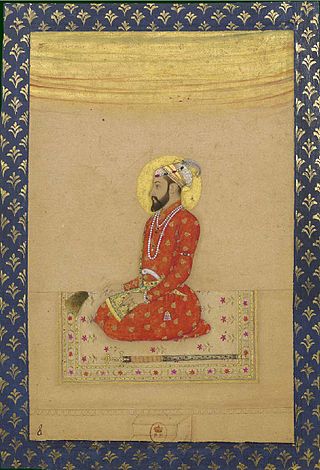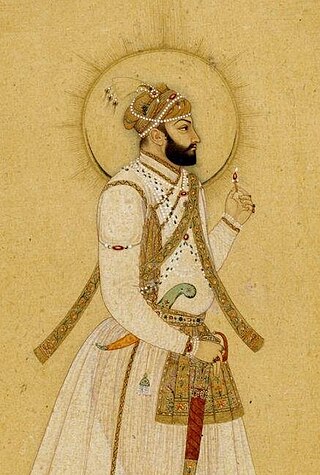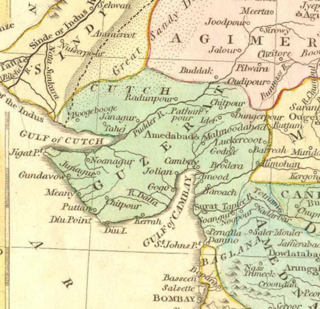
Mirza Mu'izz-ud-Din Beg Muhammad Khan, better known by his title Jahandar Shah, was briefly the ninth Mughal emperor from 1712 to 1713. He was the son of emperor Bahadur Shah I, and the grandson of emperor Aurangzeb.

Jahanara Begum was a princess of the Mughal Empire. She was the second and the eldest surviving child of Mughal Emperor Shah Jahan and Mumtaz Mahal.

Mirza Muhammad Mu'azzam, commonly known as Bahadur Shah I and Shah Alam I, was the eighth Mughal Emperor from 1707 to 1712. He was the second son of the sixth Mughal Emperor Aurangzeb, who he conspired to overthrow in his youth. He was also governor of the imperial provinces of Agra, Kabul and Lahore and had to face revolts of Rajputs and Sikhs.

Farrukhsiyar, also spelled as Farrukh Siyar, was the tenth Mughal Emperor from 1713 to 1719. He rose to the throne after deposing his uncle Jahandar Shah. He was an emperor only in name, with all effective power in the hands of the courtier Sayyid brothers. He was born during the reign of his great-grandfather Aurangzeb, Reportedly a handsome man who was easily swayed by his advisers, he was said to lack the ability, knowledge and character to rule independently. Farrukhsiyar was the son of Azim-ush-Shan, the second son of emperor Bahadur Shah I and Sahiba Niswan.

António de Andrade was a Jesuit priest and explorer from Portugal. He entered the Society of Jesus in 1596. From 1600 until his death in 1634, he was engaged in missionary activity in India. Andrade was the first known European to have crossed the Himalayas and reached Tibet, establishing the first Catholic mission on Tibetan soil.

Ippolito Desideri, SJ was an Italian Jesuit missionary and traveller and the most famous of the early European missionaries who founded Catholic Church in Tibet. He was also the first documented Tibetologist and the first European to have successfully studied both Classical and Standard Tibetan.

Roshanara Garden is a Mughal-era garden built by Roshanara Begum, the second daughter of the Mughal emperor Shah Jahan. It is situated in Shakti Nagar near Kamla Nagar Clock Tower and North Campus of University of Delhi. It is one of the biggest gardens in Delhi having a great variety of plants, some imported from Japan. The lake inside the garden is visited by migratory birds during winters and is a popular site for bird watching.

Rahmat-un-Nissa, better known by her title Nawab Bai, was a secondary wife of the Mughal emperor Aurangzeb. She gave birth to Aurangzeb's first two sons, including Bahadur Shah I, who became Mughal emperor in 1707. Nawab Bai was unpopular at the Mughal court and lost her husband's favour quite early on in her life while the misconduct of her sons, Muhammad Sultan and Muhammad Muazzam, embittered her latter life. She died in 1691 in Delhi after long years of separation from her husband and children.
Udaipuri Mahal was one of the concubines of the Mughal emperor Aurangzeb.
Aurangabadi Mahal was a consort (concubine) of the Mughal emperor Aurangzeb.
Badshah Begum was from 8 December 1721 to 6 April 1748 as the first wife and chief consort of the Mughal emperor Muhammad Shah. She is popularly known by her title Malika-uz-Zamani which was conferred upon her by her husband, immediately after their marriage.
Events in the year 1707 in India.
Zainabadi Mahal was a concubine of Mughal emperor Aurangzeb.
During the Mughal Dynasty, urdubegis were the class of women assigned to protect the emperor and inhabitants of the zenana.
Mahaldars in the Mughal Empire were the chief officers of the imperial harem. Chosen from the ranks of the darogha administrators of the zenana, the mahaldar was responsible for maintaining order in this large community of women. Niccolao Manucci writes that "the way in which these kings are waited on deserves mention. For just as the king has his officers outside, he has the same among the fair sex within the Mahal".
Nur-un-Nissa Begum was the first wife and chief consort of Mughal Emperor Bahadur Shah I.

The Gujarat Subah was a province (subah) of the Mughal Empire, encompassing the Gujarat region. The region first fell under Mughal control in 1573, when the Mughal emperor Akbar defeated the Gujarat Sultanate under Muzaffar Shah III.
Lady Juliana was a woman who lived at the court of Mughal emperor Akbar. She is said to have been the physician in charge of Akbar's royal harem, and to have married the legendary Bourbon prince Jean-Philippe de Bourbon-Navarre, and to have been the sister of one of Akbar's wives. She is credited with building the first church in Agra.

Nawab Sayyid Hussain Ali Khan Barha, officially Itisham-ul-Mulk, was a kingmaker of the later Mughal Period. Best known for ordering the death of the Emperor Farrukhsiyar largely in attempt to halt the numerous assaination attempts that the latter had ordered against him and his brother Abdullah Khan Barha. Hussain Ali Khan rose as a kingmaker in early 18th century India, when he was concurrently the governor of Ajmer and Aurangabad in the Deccan.










